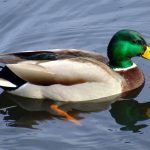 Many animals have names that inspire a verb form: because of hounds, I can hound my brother-in-law for money; because of rats, I can rat on my nefarious neighbor; and because of geese (and their tendency to pinch with their beaks), I can goose my delectable wife. The opposite occurred with ducks: they take their name from the action of ducking, not the other way around. In other words, even though the noun duck existed in English more than a thousand years ago, the verb duck came first. Still earlier, though, was another name for the duck, ende, which existed in English as far back as the eighth century. Ende has, in fact, far more relatives in other languages than duck: the Dutch, Norse, Swedish, German, Danish, and Latvian names for that water fowl are all connected to ende. In English, though, the word died out in the late fifteenth century, and that was the end of ende. There are hundreds of different kinds of ducks, but they don’t include the geoduck and the Bombay duck. The first of these, the geoduck, is a huge clam found on the Pacific coast of North America; its name—which, oddly, is pronounced like gooey duck—derives from a Nisqually phrase meaning dig deep, since these clams burrow up to three feet into the sand. Incidentally, geoducks are among the longest-living animals in the world: they can reach an age of 140 years. As for Bombay duck, that term refers to a small fish that in India is dried and used as a condiment. Also known as bummalo, the first part of the name Bombay duck appears to have arisen as a corruption of the Marathi name of the fish, bombila, and has nothing to do with the city of Bombay. The duck part of the name may have been added as a drollery, as happened with Welsh rabbit and Cape Cod turkey.
Many animals have names that inspire a verb form: because of hounds, I can hound my brother-in-law for money; because of rats, I can rat on my nefarious neighbor; and because of geese (and their tendency to pinch with their beaks), I can goose my delectable wife. The opposite occurred with ducks: they take their name from the action of ducking, not the other way around. In other words, even though the noun duck existed in English more than a thousand years ago, the verb duck came first. Still earlier, though, was another name for the duck, ende, which existed in English as far back as the eighth century. Ende has, in fact, far more relatives in other languages than duck: the Dutch, Norse, Swedish, German, Danish, and Latvian names for that water fowl are all connected to ende. In English, though, the word died out in the late fifteenth century, and that was the end of ende. There are hundreds of different kinds of ducks, but they don’t include the geoduck and the Bombay duck. The first of these, the geoduck, is a huge clam found on the Pacific coast of North America; its name—which, oddly, is pronounced like gooey duck—derives from a Nisqually phrase meaning dig deep, since these clams burrow up to three feet into the sand. Incidentally, geoducks are among the longest-living animals in the world: they can reach an age of 140 years. As for Bombay duck, that term refers to a small fish that in India is dried and used as a condiment. Also known as bummalo, the first part of the name Bombay duck appears to have arisen as a corruption of the Marathi name of the fish, bombila, and has nothing to do with the city of Bombay. The duck part of the name may have been added as a drollery, as happened with Welsh rabbit and Cape Cod turkey.
A type of avian creature that possesses webbed feet exists in both wild and domesticated varieties. The meat of this bird is typically dark, and while ducklings may contain more fat than chicken, the quantity of flesh on the bones is limited. As such, it is advisable to allocate approximately 12 ounces of dressed duck per individual. Wild duck is classified as game and is only in season for a brief period of time. It is typically served roasted and undercooked. Domesticated ducklings that are raised specifically for consumption are classified as poultry and are easily obtainable in a frozen state. When preparing fresh duckling, it is recommended to choose a younger bird as its flesh is more tender. This bird can be roasted and served with various accompaniments, such as stuffing, applesauce, or orange sauce.
